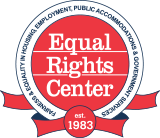WEBSITE ACCESSIBILITY: THE NEXT BIG CHALLENGE IN FAIR HOUSING?
As housing search and application processes are increasingly conducted online, housing websites must take steps to become fully accessible to people with disabilities using assistive technologies.
By Aastha Uprety
April 30, 2019
A laptop rests on a wooden table outdoors. On the screen, the cursor hovers over a photo of a house.
In recent years, website accessibility has become a hot topic in the disability rights movement. Website accessibility refers to the extent to which a website is fully usable by people with disabilities, especially those using assistive technologies such as screen readers. Americans with disabilities are less likely to go online on a regular basis than their counterparts without disabilities, and part of this may be due to inaccessibility. Without being able to fully use websites, people with disabilities can struggle to apply for jobs, shop online, meet new people, access entertainment, and even find a place to live.
Inaccessible websites can prevent people with disabilities from accessing information about businesses in the same way as their non-disabled counterparts, and thus, Americans with Disabilities Act (ADA) lawsuits related to this issue have gained prominence in the past few years. However, with the rise of virtual housing searches and online rental applications, it is becoming far harder to ignore that inaccessible websites may have major implications for Fair Housing Act (FHA) compliance as well.
What is website accessibility?
Website accessibility is the purposeful design of webpages to be accessible for and usable by people with disabilities. When a website is inaccessible, blind individuals, those with limited mobility, people who experience seizures, and others may be unable to fully use the website. Often times, people with disabilities use assistive technologies to help them navigate the web. One example of an assistive technology is a screen reader—a software program that converts text on a computer screen to audible speech or braille display for people who are blind or visually impaired. It can also be used by people with other disabilities like learning disabilities. Inaccessible websites might include elements that screen readers cannot properly interpret, feature GIFs and flashing lights or colors, or make it difficult for users to navigate using just the keyboard.
Section 508 of the Rehabilitation Act requires federal government websites to be accessible, and in January 2017, the United States Access Board published regulations that define accessibility for federal agency websites in terms of compliance with Website Content Accessibility Guidelines 2.0 (WCAG 2.0). Many private entities committed to accessibility also use the WCAG 2.0 to develop their websites. However, even though the ADA requires effective communication by entities that communicate with the public, the federal government has not formalized official website accessibility standards for ADA compliance. In fact, in December 2017, the DOJ revoked draft rules on the topic after having worked for years to promote them.
Regardless, even though the federal government has yet to issue detailed guidance about website accessibility under the ADA, public accommodations must still meet their obligations for effective communication. In recent years, ADA-related website accessibility lawsuits have gained prominence and brought increased attention to the issue of online accessibility. In January of this year, for example, the Ninth Circuit ruled that Domino’s website and pizza-ordering mobile app must be accessible to blind customers using screen readers.
As public accommodations are required under the ADA to communicate effectively with the public, ADA-based lawsuits about the accessibility of websites, the main way for businesses to communicate with their customers these days, have been in the spotlight. Website accessibility, however, is important for more than just public accommodations. It’s also crucial to people with disabilities who are looking for housing.
The Fair Housing Act and protections for people with disabilities
The Fair Housing Act (FHA) is a cornerstone of civil rights protections in the United States. The FHA protects people from discrimination when they are buying or renting a home, taking out a mortgage, seeking housing assistance, or engaging in other housing-related transactions. The original law, passed in 1968, protected people against discrimination on the basis of race, color, national origin, and religion. Sex was added as a protected class under the law in 1974, and the Fair Housing Amendments Act of 1988 (FHAA) added protections on the basis of familial status and disability.
People with disabilities face numerous obstacles when finding a place to live, and while problems persist, the FHA made immense improvements in the housing opportunities available to people with disabilities. Under the FHA, people with disabilities may request reasonable accommodations and modifications to allow them to fully use and enjoy their homes. In addition, it is illegal for landlords, property managers, and others to discriminate on the basis of someone’s disability.
However, website inaccessibility prevents many people with disabilities from even finding housing in the first place. The ERC regularly hears from housing providers about the obsolescence of physical leasing offices and the growing importance of online housing advertisements and rental applications. Indeed, a 2016 survey from TransUnion found that 56 percent of rental property managers saw an increase in online housing applications in the previous year. The ERC has encountered housing providers in the Greater Washington, D.C. area who only accept applications online. When housing websites are not accessible to people with disabilities, they effectively exist as another barrier to equal housing opportunity.
Online barriers to housing for people with disabilities
Last month, the ERC released a report based on a civil rights testing investigation into housing accessibility for people with disabilities. The report detailed numerous barriers to access for people with disabilities searching for housing in the Greater Washington, D.C. area, both online and in person. The online testing, in particular, revealed striking results.
The ERC used matched-pair testing to compare the experiences of a blind tester and a sighted tester while navigating the websites of multifamily housing providers. The blind tester relied on a screen reader to navigate the websites. In total, the ERC tested 25 websites in both their desktop and mobile forms.
Results showed that in 84 percent of desktop versions of websites tested and 76 percent of mobile versions, the blind tester faced accessibility barriers when trying to determine unit availability, filtering search results by preferred unit size, and/or learning about rent specials. In addition, 16 of the websites tested had online applications; 13 of these were inaccessible to screen readers. This prevented the blind tester from being able to fill out or submit the application independently. If the results of these website tests were applied to in-person visits, they suggest that in 81 percent of visits, a blind visitor would not even be able to submit an application.
In the span of less than a generation, the internet has completely transformed our world. It offers the promise of increased access and integration for people with disabilities that most of us couldn’t even conceive of prior to its existence. But unless technological advancement actively includes people with disabilities, they will continue to be left behind well into the future.
Website accessibility is rightfully gaining attention as an important piece of the movement for accessibility and disability rights. As the world becomes increasingly digital, let’s not forget that websites are crucial for housing opportunity as well as public accommodations. Browsing the internet is the first step for many when it comes to finding a place to live. As reliance on online housing searches and rental applications increases, the responsibility of housing providers to ensure access in the digital realm is becoming more obvious. Housing providers should prioritize the development of accessible websites, and advocates should pay attention to website accessibility as an emerging fair housing issue.
If you believe you may have experienced discrimination in housing, you can contact the Equal Rights Center. To report your experience, please call 202-234-3062 or email info@equalrightscenter.org.


